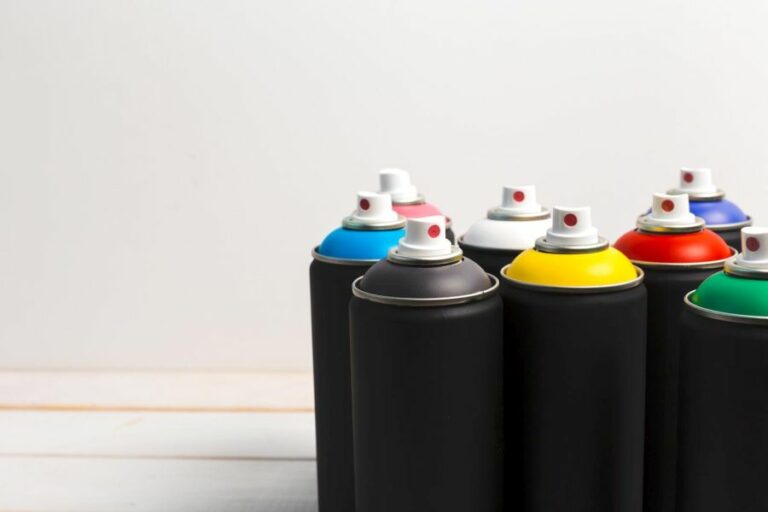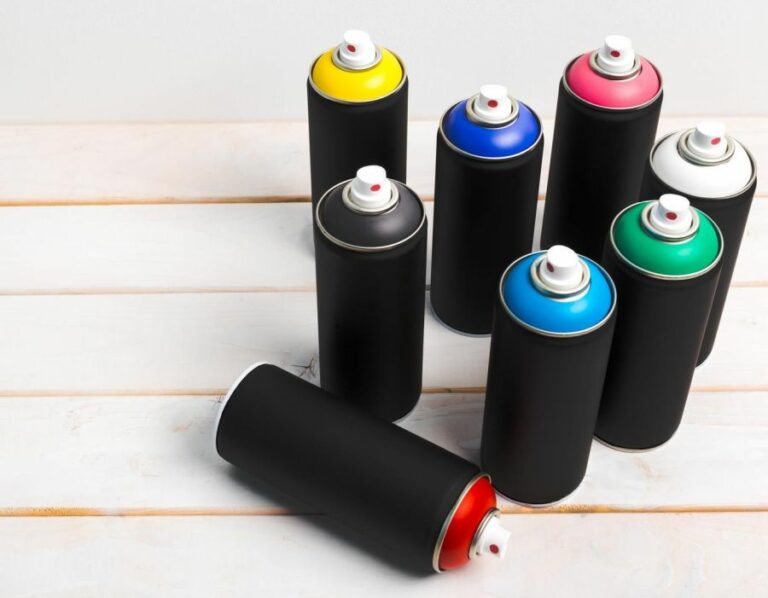Spray Paint Removal For All Surfaces
Are you tired of struggling with stubborn spray paint that just won’t budge from various surfaces? Fret not because we have the ultimate guide on spray paint removal for all surfaces! With our tried and tested techniques, you can finally restore those surfaces to their former glory.
Spray paint removal for all surfaces:
To remove spray paint from various surfaces, use solvents or pressure washing for metal, razor blades, or acetone-based nail polish remover for glass, sanding or heat guns for wood, power washing or poultices for concrete, and rubbing alcohol for fabric. Exercise patience and attention to detail to avoid damaging surfaces.

Eager to restore your surfaces to their original state after an unwelcome spray paint encounter? Discover how to safely and effectively remove paint from various surfaces within your reach!
We’ve got more tips and tricks waiting for you. Keep reading and uncover the best paint removal methods to suit your needs.
Contents
- 1 Efficient Spray Paint Removal on Various Surfaces
- 2 Safe Methods to Eliminate Spray Paint from Surfaces
- 2.1 • Safety First: Preparing for Paint Removal
- 2.2 • Metal Surfaces: Effective Techniques for Spray Paint Removal
- 2.3 • Plastic and Other Delicate Surfaces: Gentle Spray Paint Removal Techniques
- 2.4 • Glass Surfaces: Easy and Effective Spray Paint Removal
- 2.5 • Wood Surfaces: Natural and Commercial Solutions
- 3 Effective Techniques for Removing Spray Paint on Metal
- 4 Top Solutions for Paint Stripping from Different Surfaces
- 5 Acetone: Can it Remove Spray Paint from Concrete?
Efficient Spray Paint Removal on Various Surfaces
Spray paint is a popular choice for a range of DIY projects and crafts due to its ease of application and quick drying time. However, mistakes happen, and you may find yourself needing to remove paint from various surfaces.
• Removing Spray Paint from Metal
Metal surfaces can often be spray painted for protection or to change their appearance. However, if you need to remove paint from a metal surface, there are a few tried-and-true methods available.
– Using Solvents
A chemical paint remover could be your best bet for lifting off the spray paint without harming the metal surface. Look for a solvent that specifically targets paint, such as paint thinner or mineral spirits. Apply the solvent using a clean cloth or sponge until the paint starts to break down.
Once the paint has softened, you can scrape it off gently with a plastic scraper or the edge of a credit card.
Expert Recommendation: Wear gloves and work in a well-ventilated area when working with solvents.
– Using a Pressure Washer
Another option for removing spray paint from a metal surface is to use a pressure washer. This method is particularly effective for large or outdoor surfaces. Ensure that the pressure washer setting is on a low to medium level to avoid accidentally causing damage to the surface.
Always wear appropriate safety gear, such as goggles and closed-toe shoes, while using a pressure washer.
• Removing Spray Paint from Glass
Glass surfaces are delicate and prone to scratches, so you should take care when removing paint. Here are a few options for a damage-free paint removal process.
– Using a Razor Blade
For small areas or precise work, a razor blade can be an effective tool for removing paint. Dampen the area with water or a glass cleaner, then gently scrape off the paint with the blade, maintaining a low angle to avoid scratching the glass.
– Using Nail Polish Remover
Acetone-based nail polish remover is another option for removing spray paint from glass surfaces. Apply the nail polish remover with a clean cloth, working in small sections, and then use a plastic scraper to gently lift the paint.
• Removing Spray Paint from Wood
Wooden surfaces can be tricky, as paint often seeps into the porous material. However, there are a few methods for effectively removing spray paint from wood.
– Sanding
One effective method for removing paint from wood is through sanding. Start with coarse-grit sandpaper to remove the paint layers, then switch to a finer grit to smooth out the surface.
This method may remove the finish of the wood, so you may need to refinish the surface after removing the paint.
– Using a Heat Gun
A heat gun can help loosen and lift the spray paint from the wood surface. Hold the gun approximately 6-8 inches away from the surface and move it slowly over the paint, applying steady heat until the paint starts to bubble.
Use a plastic scraper to remove the softened paint. Follow up with fine-grit sandpaper to smooth the surface.
• Removing Spray Paint from Concrete
Concrete surfaces can be particularly difficult to clean due to their rough texture. However, it is possible to remove spray paint from concrete using the right approach.
– Power Washing and Bristle Brush
Rent or purchase a power washer to target larger areas of spray paint on concrete. Start with a medium pressure setting and adjust as needed based on the surface and paint.
To help loosen the paint, follow up with a stiff-bristle brush, scrubbing any stubborn spots in a circular motion until the paint is removed.
– Using a Poultice
A paint removal poultice is another option for drawing out paint from concrete surfaces. Applying a poultice made of trisodium phosphate and an absorbent material like talc, plaster of Paris, or diatomaceous earth can help lift the paint stain.
This method can take several hours or even days to work, but it can provide positive results without causing damage to the concrete surface.
• Removing Spray Paint from Fabric
Removing spray paint from fabric can be challenging, but it is possible if addressed promptly.
– Using Rubbing Alcohol
Dampen a clean cloth or cotton swab with rubbing alcohol and dab the paint stain carefully, working from the outside edge of the stain inward to avoid spreading it.
Continue to apply the rubbing alcohol until the stain is removed, then follow up with regular laundering according to the fabric care instructions.
In conclusion, removing spray paint from various surfaces requires attention to detail, the right tools, and patience.
Follow these expert tips and tricks for successful paint removal, and you’ll be well on your way to salvaging your projects and restoring surfaces back to their original condition.
Safe Methods to Eliminate Spray Paint from Surfaces
Spray paint can be a great tool for adding color and decoration to various surfaces. However, there can be instances when the paint ends up where it shouldn’t. In such cases, it’s crucial to know how to remove spray paint without causing damage to the underlying surface.
• Safety First: Preparing for Paint Removal
Before attempting to remove spray paint, it’s important to gather the necessary materials and take appropriate safety precautions. This may involve wearing gloves, protective eyewear, and working in a well-ventilated area.
Additionally, it’s important to test removal products on an inconspicuous area of the surface to ensure no damage occurs during the process.
• Metal Surfaces: Effective Techniques for Spray Paint Removal
Fortunately, metal surfaces are among the easiest materials to clean spray paint from without causing damage. Here are a few methods, from gentle to more aggressive, that can effectively remove spray paint from metal:
– Soap and Water
For fresh paint stains, a simple solution of mild dish soap and warm water can work wonders. Apply to the affected area and use a soft cloth or sponge to gently rub the paint away. Rinse thoroughly with clean water and repeat if necessary.
– Rubbing Alcohol
For more stubborn stains, rubbing alcohol (isopropyl alcohol) is an effective solvent for removing dried spray paint from metal. Apply with a cotton ball or soft cloth, rubbing gently until the paint is dissolved. Use a separate cloth to wipe the area clean and rinse with water.
– Acetone or Paint Thinner
In cases of extreme paint build-up, a stronger solvent such as acetone or paint thinner may be required. Apply with a soft cloth, and, as with rubbing alcohol, gently rub the affected area until the paint dissolves.
Be cautious, as these solvents can be harsh and may damage some surfaces. Always test in an inconspicuous area first, and work in a well-ventilated area while wearing gloves.
• Plastic and Other Delicate Surfaces: Gentle Spray Paint Removal Techniques
Removing spray paint from plastic or other delicate surfaces can be trickier, as these materials are more likely to be damaged by harsh chemicals or abrasive tools. The following gentle methods can minimize the risk of damage while effectively removing unwanted paint:
– Vegetable Oil
A surprising yet effective paint remover, vegetable oil can be applied with a soft cloth to gently lift away spray paint from delicate surfaces such as plastic or rubber. Use a separate cloth to wipe the paint away, and rinse with warm, soapy water.
– Nail Polish Remover
Non-acetone nail polish remover is a gentle alternative to paint thinner and can be effective at removing spray paint from plastic surfaces. Apply with a cotton ball or soft cloth, rub gently, and rinse with clean water.
– Baking Soda and Water
A paste made from baking soda and water can be used to gently scrub away spray paint without the risk of scratching delicate surfaces. Apply the paste with a soft cloth or sponge, rub gently, and rinse clean.
• Glass Surfaces: Easy and Effective Spray Paint Removal
When dealing with spray paint on glass surfaces, a combination of gentle yet effective methods can help remove the paint without causing scratches:
– Razor Blade
A razor blade can be highly effective at removing spray paint from glass without causing damage. Hold the blade at an angle to the surface and carefully scrape the paint away, being mindful not to scratch the glass.
– White Vinegar
Heating white vinegar and applying it to the spray paint on glass can help loosen the paint, making it easier to remove. Saturate a cloth with the warm vinegar and place it over the painted area for a few minutes.
Then, use a clean cloth or razor blade to gently remove the loosened paint.
• Wood Surfaces: Natural and Commercial Solutions
Removing spray paint from wood can be tricky, as the porous nature of the material can make paint difficult to remove without causing damage. Try these options for paint removal:
– Sandpaper
For unfinished wood or surfaces where light damage can be tolerated, sandpaper can be used to remove the paint. Begin with a coarse grit, and gradually work up to a finer grit to avoid gouging the wood.
– Commercial Paint Remover
There are a variety of commercial paint removers on the market designed specifically for use on wood surfaces, such as Citristrip or Soy Gel. Always follow the manufacturer’s instructions and test on an inconspicuous area first.
In conclusion, proper care and attention to the specific needs of various surfaces can ensure the successful removal of spray paint without causing damage. Always take safety precautions and test your chosen method on a hidden area before attempting large-scale paint removal.
Apply the recommended techniques with patience, and you’ll have clean, paint-free surfaces in no time!
| How to remove spray paint without damaging surfaces? | |
|---|---|
| 1. Test the surface: | Apply a small amount of paint remover in an inconspicuous area to ensure it won’t damage the surface. |
| 2. Use a paint thinner or remover: | Choose a paint thinner or remover that is compatible with your surface. Apply the remover and let it sit for the recommended time before gently rubbing it off. |
| 3. Scrape off paint: | Use a plastic scraper or the edge of a credit card to gently scrape the loosened paint. Be careful not to scratch the surface underneath. |
| 4. Use a sponge or cloth: | Soak a sponge or cloth in warm water and a mild soap or detergent. Gently rub the area to remove any remaining paint residue. |
| 5. Rinse with water: | Rinse the surface with clean water to remove any remaining soap or paint remover. |
| 6. Dry the surface: | Use a clean, dry cloth to thoroughly dry the surface. |
| 7. Buff the surface: | If necessary, use a microfiber cloth and a gentle rubbing compound to buff and restore the surface’s shine. |
Effective Techniques for Removing Spray Paint on Metal
When it comes to removing spray paint from metal, many people can face a daunting challenge. Whether it’s an accidental overspray or vandalism, it’s crucial to have the right tools and knowledge to achieve the desired outcome.
• Chemical-based Approaches
– Using Acetone
Acetone is a powerful and widely available solvent that can effectively break down and remove spray paint from metal surfaces.
- Wear protective gear: Acetone can be harmful to your skin and eyes, so wear gloves and goggles before handling it.
- Apply acetone: Soak a clean cloth or sponge in acetone and gently scrub the affected area until the paint starts to dissolve.
- Rinse and repeat: Rinse the area with water and repeat the process if necessary until the spray paint is entirely removed.
- Neutralize and clean: Once all paint is gone, rinse the surface with water and use a mild soap to clean any remaining residue.
– Using Paint Thinner or Lacquer Thinner
Another effective method for removing spray paint from metal surfaces is using paint thinner or lacquer thinner. As powerful solvents, these products can efficiently break down and remove paint.
- Wear protective gear: Similar to acetone, these solvents can be harmful, so wear gloves and goggles.
- Apply the thinner: Soak a clean cloth or sponge in the chosen thinner and gently scrub the affected area.
- Rinse and repeat: Rinse the area with water and repeat the process if necessary until the paint is removed.
- Neutralize and clean: Rinse the surface with water and cleanse with mild soap to eliminate any remaining residue.
– Using Graffiti Remover
There are also commercial graffiti removers available in the market explicitly designed for removing spray paint from different surfaces, including metal.
- Follow directions: Always read and follow the instructions on the product label to ensure the best results.
- Apply the graffiti remover: Spray or apply the product onto the affected area and allow it to penetrate the paint for the designated time.
- Scrub the area: Using a cloth, sponge, or soft brush, gently scrub the area to remove the paint.
- Rinse and repeat: Rinse the area with water and repeat if required until the spray paint is gone.
- Clean: Clean the surface with soap and water to remove any residue.
• Mechanical-based Approaches
– Sanding
Sanding is a powerful mechanical method for removing spray paint from metal surfaces. This process requires care and attention to prevent scratching and damaging the metal surface.
- Choose the right grit: Select sandpaper with an appropriate grit to remove the paint without causing too much damage to the metal.
- Sand the paint away: Gently sand the affected area to remove the paint layer by layer until the metal surface is revealed.
- Smooth the area: Once the paint is gone, switch to finer-grit sandpaper to smooth out the surface and remove any scratches.
- Clean: Wipe the surface clean with a damp cloth to remove any remaining dust and debris.
– Using a Wire Brush
A wire brush is another effective tool for removing spray paint from metal surfaces, especially when dealing with rougher surfaces or stubborn paint.
- Choose the right brush: Select a wire brush with bristles made of a softer metal than the surface you’re working on to prevent scratching.
- Scrub the area: Gently scrub the affected area with the wire brush, using a back-and-forth motion to remove the paint.
- Clean: Wipe the surface clean with a damp cloth to remove any remaining paint particles.
• Precautionary Measures
When removing spray paint from metal surfaces, always keep the following safety measures in mind:
- Always work in a well-ventilated area when using chemical-based solutions.
- Wear protective gear, such as gloves, goggles, and a face mask, when working with chemicals or mechanical tools.
- Test the chosen method on a small, inconspicuous area of the surface first to ensure compatibility and avoid potential damage.
- Dispose of any cleaning materials, such as cloths, sponges or chemicals, according to local regulations and guidelines.
In conclusion, removing spray paint from metal surfaces requires a strategic approach, using either chemical or mechanical methods or a combination of both. With the right tools, knowledge, and safety measures, one can efficiently and effectively restore metal surfaces to their original state. For more information and safety guidelines regarding chemicals, consult the United States Environmental Protection Agency.
Top Solutions for Paint Stripping from Different Surfaces
Removing paint from various surfaces can be a challenging task. However, with the right knowledge and tools, it is possible to achieve a clean and professional finish.
• Paint Removal from Wood
When it comes to removing paint from wooden surfaces, there are several options to consider. The most common methods include the use of a heat gun, chemical strippers, and sanding.
– Heat Gun Method
A heat gun is a powerful tool that emits hot air, capable of softening paint and making it easier to scrape away. This method is highly effective, especially for removing multiple layers of paint.
How to use a heat gun:
- Turn on the heat gun and adjust it to the appropriate temperature (usually around 500-600F).
- Hold the heat gun at a 45 angle, 2-3 inches away from the surface.
- Move the heat gun back and forth, allowing the paint to soften and blister.
- Use a scraper or putty knife to remove the softened paint.
- Clean the surface with a damp cloth to remove any residue.
Important tips:
- Always wear heat-resistant gloves and protective eyewear when using a heat gun.
- Never point the heat gun at any flammable materials.
- Use caution when working on surfaces with lead-based paint, as the fumes can be harmful.
– Chemical Strippers
Chemical paint strippers are solvents that break down the paint’s bond with the surface, allowing it to be easily removed. There are various types of chemical strippers available, including eco-friendly options, which are less harmful to both the environment and the user.
How to use chemical strippers:
- Choose the appropriate type of chemical stripper for your specific paint and surface.
- Apply the chemical stripper as per the manufacturer’s instructions, usually with a brush or roller.
- Allow the stripper to work on the paint for the recommended time.
- Use a scraper or putty knife to gently remove the loosened paint.
- Clean the surface with a damp cloth or mineral spirits to remove any residue.
Important tips:
- Always wear gloves, eye protection, and a mask when working with chemical strippers.
- Work in a well-ventilated area or outdoors if possible.
- Dispose of the used paint and stripper following your local waste disposal guidelines.
– Sanding
Sanding is an effective method for removing paint from wood. This can be done by hand or with a power sander, depending on the size of the surface and the amount of paint to be removed.
How to sand paint off wood:
- Choose the appropriate grit sandpaper for your project, starting with a coarse grit (60-80) and working your way up to finer grit (120-220).
- Always sand in the direction of the wood grain to avoid damaging the surface.
- If using a power sander, start at a low speed and gradually increase as needed.
- Wipe the surface with a damp cloth to remove dust and debris.
Important tips:
- Wear eye protection and a mask to avoid inhaling dust.
- Be cautious when sanding surfaces with lead-based paint, as sanding releases harmful particles.
- Monitor the wood surface carefully, as oversanding can cause damage or unevenness.
• Paint Removal from Metal
Metal surfaces require different paint removal solutions, as some methods used for wood can cause damage. The most effective methods for removing paint from metal include chemical strippers, abrasive blasting, and wire brushes.
– Chemical Strippers for Metal
Some chemical strippers are specifically formulated for use on metal surfaces. These products are designed to break down paint and coatings without causing damage to the metal underneath.
Follow the same application and safety tips for chemical strippers as mentioned in the wood section above.
– Abrasive Blasting
Abrasive blasting, such as sandblasting or soda blasting, is an effective method for removing paint from metal surfaces. This method involves using compressed air to propel abrasive media against the surface, removing the paint as a result.
Abrasive blasting is often used for larger projects or when removing tough, industrial coatings.
It is generally recommended to hire a professional for this process, as improper technique can cause damage to the metal surface.
– Wire Brushes
Manual or power wire brushes can be used to remove paint from metal surfaces. This method requires more effort than chemical strippers or abrasive blasting but is an affordable option for smaller projects.
How to use a wire brush:
- Choose the appropriate type of wire brush for your project (manual or power attachment).
- Wear eye protection, gloves, and a mask to avoid injury and particle inhalation.
- Begin brushing the surface, applying even and firm pressure.
- Clean the surface with a damp cloth or mineral spirits to remove any residue.
• Paint Removal from Concrete
Concrete surfaces often require different paint removal methods due to their porous nature. The most effective approaches for removing paint from concrete include chemical strippers, pressure washing, and grinding.
– Chemical Strippers for Concrete
Using a chemical stripper specially designed for concrete surfaces can be an effective method for removing paint. Follow the application and safety steps mentioned earlier in the wood and metal sections.
– Pressure Washing
Pressure washing can be an effective method for removing paint from concrete surfaces, particularly for larger areas or outdoor projects. It is important to use the correct pressure setting and nozzle to avoid damaging the concrete.
– Grinding
For stubborn paint or thick coatings, grinding the concrete surface with a concrete grinder or floor polishing machine can be effective. This method should only be carried out by experienced individuals or professionals, as improper use can cause damage to the concrete.
In conclusion, the best method for removing paint from a surface will depend on the type of surface, the type and age of the paint, and the desired result. Remember to always prioritize safety and adhere to manufacturers’ instructions when using any paint removal method.
Methods | Description |
|---|---|
Soapy Water | For water-based paint, warm soapy water and a scrubbing sponge usually work best. |
Chemical Paint Removers | Use paint strippers or removers for heavy or stubborn paint, following manufacturer instructions. |
Heat Gun | Apply heat to soften the paint, then use a scraper to remove it, being careful not to damage the surface. |
Sanding | For larger areas, using sandpaper or a power sander can effectively remove paint. |
Pressure Washing | On outdoor surfaces, a pressure washer can help remove paint when used with caution. |
Acetone: Can it Remove Spray Paint from Concrete?
Acetone is a powerful and effective solvent that is commonly used in various cleaning applications, particularly for dissolving and removing paints and other similar substances. But the question arises – will acetone remove spray paint from concrete surfaces?
The answer to this question is yes; acetone can be used to remove spray paint from concrete. However, it is essential to consider some factors like the type of concrete, the age and condition of the concrete, and the appropriate technique when using acetone.
• Understanding the Properties of Acetone
Before diving into the process of removing spray paint from concrete, it is essential to understand the properties of acetone. Acetone, a colorless and volatile liquid, is an excellent organic solvent that is capable of dissolving a wide variety of materials.
It is a popular choice for various cleaning and paint removal applications because it evaporates quickly and leaves no residue.
As an effective solvent, acetone can dissolve many types of paints, adhesives, resins, and other substances, making it suitable for removing spray paint from concrete surfaces.
However, it is crucial to exercise caution when using this chemical, as it is highly flammable and can harm some materials, including plastic and rubber.
• Testing the Concrete Surface
Before applying acetone to remove spray paint from concrete, it is essential to determine the type, age, condition, and porosity of the concrete. Some concrete surfaces, such as precast or stained concrete, may be susceptible to damage when using a solvent like acetone.
When dealing with an unfamiliar concrete surface, it is recommended to test a small, inconspicuous area first. This test will help you determine if acetone is an appropriate and safe choice for the specific concrete you are working with.
• Preparing the Area and Materials
Before attempting to remove spray paint from concrete with acetone, follow these steps to ensure safety and efficiency:
- Gather Safety Materials: Wear appropriate safety gear, such as gloves and safety goggles, and ensure that the working area is well-ventilated.
- Clean the Surface: Sweep or vacuum the concrete surface to remove dust and debris, which can hinder the effectiveness of acetone.
- Gather Materials: Acquire acetone from a hardware store, along with a paint scraper, a scrub brush, and a few clean, white rags or cloths.
• The Process: Removing Spray Paint from Concrete with Acetone
Follow these steps to remove spray paint from concrete using acetone:
- Apply Acetone: Dampen a clean, white rag or cloth with acetone. Carefully apply the acetone to the spray paint on the concrete surface.
- Allow Acetone to Penetrate: Let the acetone sit on the spray paint for a few minutes to dissolve the paint. To prevent overexposure, avoid leaving the acetone on the surface for longer than necessary.
- Scrape Off the Paint: Use a paint scraper to gently scrape away the dissolved paint. Be cautious and gentle, as scraping too aggressively could damage the concrete surface.
- Scrub the Surface: Dip a scrub brush in acetone and scrub the remaining paint residue. This step may need to be repeated multiple times, depending on the extent of the spray paint and the effectiveness of the acetone.
- Clean the Area: Once the spray paint has been removed, clean the area with water and mild detergent. This step will help remove any remaining acetone and paint residue, as well as neutralize any potential damage to the concrete surface.
- Allow to Dry: Let the area dry completely before using or sealing the concrete.
• Alternative Methods for Removing Spray Paint from Concrete
If acetone proves ineffective or is unfit for your specific concrete surface, consider other alternative methods for removing spray paint from concrete, such as:
- Power Washing: Using a power washer can effectively remove spray paint from concrete, especially for outdoor applications.
- Paint Remover Solutions: Many commercially available paint remover solutions are designed for use on concrete surfaces.
- Mechanical Abrasion: Using abrasive tools or sandblasting can also remove spray paint from concrete, but caution is needed to avoid damaging the concrete surface.
• Final Thoughts
In conclusion, acetone is an effective and powerful solvent for removing spray paint from concrete surfaces.
However, careful consideration must be given to the type, age, and condition of the concrete, as well as adherence to safety precautions when using this chemical.
Testing the concrete surface first and following the appropriate steps will help ensure the successful removal of spray paint from concrete while preserving the integrity of the surface.







